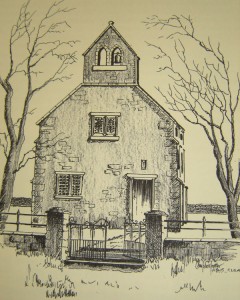St Chad’s is one of the five churches in the Benefice of Lastingham, in the Anglican Diocese of York.
Records show that at the end of the 19th Century services were being held in the village School Room, until in 1901 when a disused chapel, known as Zion Chapel, was purchased. This was situated next to the site of the present church and was dedicated to St Chad. In 1934 it was replaced by the present building, also dedicated to St Chad.
Zion Chapel
Who was St Chad?
St Chad was one of the three brothers of St Cedd, all monks from Lindisfarne, who in 654AD founded Lastingham Church as a Celtic Monastery. After Cedd’s death in 664AD, Chad became Abbot of Lastingham. Soon afterwards, however, he was in conflict between the Celtic way and the more structured Roman way, which had taken precedence over the Celtic way at the Synod of Whitby in 664AD. Chad was later consecrated Bishop of Lichfield. His feast day is 2nd March.
St Chad’s
Special features of St Chad’s
These include: a wooden alter with stone mensa; a lovely oak reredos from Welburn Hall; alter rails made of oak from Douthwaite Hall; a Font and Lectern from Ryton Church; pews from All Saints, Kirkbymoorside; some good post-war stained glass in the sanctuary, depicting to the north St Chad, and to the south the Annunciation; a very good one-manual organ made in the 1860s, with seven speaking stops (it came from a Methodist Chapel in Scarborough, but originally was probably a chamber organ in a private house); and the stone carved cross from above the door of the old church, incorporated into the north boundary wall. A leaflet covering these features and other facts is available from the church.
Vicars of Lastingham
Over the past 100 years, as follows;
| 1890 | James Salman |
| 1905 | Frank Henry Weston |
| 1916 | John Edwin Hine |
| 1918 | Joseph Day |
| 1932 | Thomas Edwards |
| 1941 | Cecil Thompson |
| 1953 | Edward Mowforth |
| 1957 | John Stewart |
| 1975 | Theodore Hawkins |
| 1981 | Francis Hewitt |
| 1995 | David Bryant |
| 2000 | Alastair Ferguson |
What is the Church for?
A place of beauty and tranquility in which to reflect and pray and celebrate the Christian Tradition; a context for christenings, weddings and funerals; a building for concerts, flower festivals, etc; a focus of community.
The Churchwardens
These are lay people who take the lead in representing the people and working with the Parish Priest. They undertake both pastoral and administrative duties.
Pastoral Duties include generally caring for the priest and people of the parish, making things happen and helping to smooth over difficulties.
Adminstrative Duties include the day-to-day care of the buildings and furniture; keeping up the Inventory and Log Book; putting in hand any necessary work to repair or replace; and causing all necessary funds to be raised.
Churchwardens are elected for a period of one year at the Annual Meeting of Parishioners. They derive their authority from the bishop. Each parish normally has two churchwardens, but by custom Hutton le Hole has two deputy wardens in addition to those at Lastingham.
The Annual Meeting
This is held in March or April. The shorter first part, that is open to everyone resident in the Parish, elects the churchwardens for the year. The second part, that is open to those on the Church Electoral Roll, receives various reports for the year (including the Financial Statements), and it elects members of the Parochial Church Council and Deanery Synod for the coming year.
The Sacristan
This person is appointed by the priest to look after the Church’s sacred vessels and vestments, and prepares all the necessities for the celebration of the Eucharist.
Visits and Confirmation Classes
The Vicar is always pleased to hear of anyone who may like a visit for any reason. Please ring 01751 417344
Confirmation Classes are held during term time – please contact the Vicar for details.
Who Pays to Run the Church?
All the funds for running the local church, including payment of the clergy, upkeep and insurance of the building, and right down to buying of bread and wine, must be raised from the five villages – no central funds are available.
Other Christian Denominations that once flourished
Since the Reformation, besides the Church of England, Hutton le Hole has had Quakers, Methodists (who built the Wesleyan Chapel in 1816, restored in 1878), Primitive Methodists (who built their Chapel in 1863) and Congregationalists who built the Zion Chapel in 1840.

